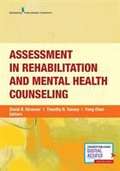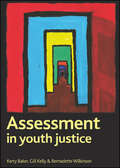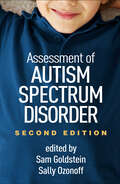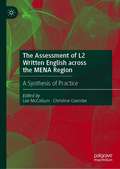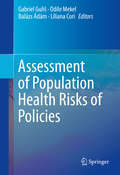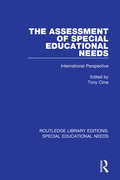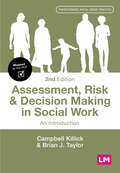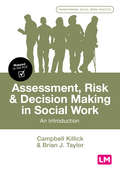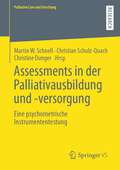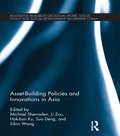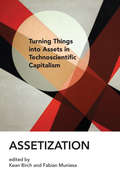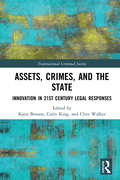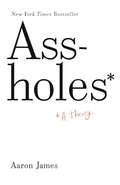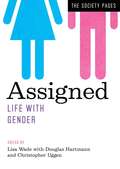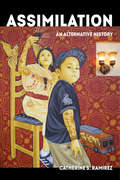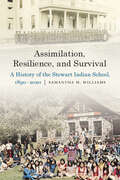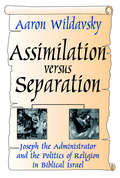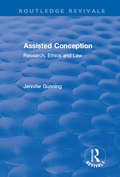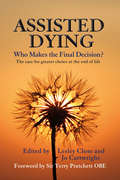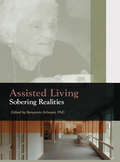- Table View
- List View
Assessment In Rehabilitation And Mental Health Counseling
by David R. Strauser Timothy N. Tansey Fong ChanThis graduate-level text on rehabilitation and mental health counseling disseminates foundational knowledge of assessment principles and processes with a focus on clinical application. Written by recognized leaders in rehabilitation and mental health, it is the only book to use the World Health Organization's International Classification of Functioning, Disability and Health (ICF) framework to integrate assessment tools and techniques addressing practice with varied populations and settings. <p><p> Written by leading practitioners with specialized knowledge, chapters focus on specific populations and service delivery settings. The book features a variety of learning tools to foster critical thinking, including learning objectives and case examples highlighting important principles and applications. Sample reports and templates further reinforce understanding of specific applications.
Assessment in youth justice
by Kerry Baker Gill KellyThis book provides a comprehensive introduction to the theory and practice of assessment and intervention planning with young people who offend. It will help equip practitioners with the knowledge and professional skills central to these critically important tasks. The context for practice is changing rapidly and the authors take into account current policy developments along with a wide range of literature on assessment practice in criminal justice and social care. The book encourages readers to think critically and to take practical steps to enhance their own practice. It will be important reading for anyone working with young people who offend.
Assessment of Autism Spectrum Disorder, Second Edition
by Sam Goldstein Sally OzonoffThis authoritative resource, now thoroughly revised for DSM-5, has set the standard for the comprehensive assessment of autism spectrum disorder (ASD). Leading experts demonstrate how to craft a scientifically grounded profile of each child’s strengths and difficulties, make a formal diagnosis, and use assessment data to guide individualized intervention in clinical and school settings. Chapters review state-of-the-art instruments and approaches for evaluating specific areas of impairment in ASD and co-occurring emotional and behavioral disorders. Considerations in working with children of different ages are highlighted. With a primary focus on children, several chapters also address assessment of adolescents and adults. New to This Edition *Chapter on key implications of DSM-5 diagnostic criteria, plus related updates throughout the volume. *Chapter on advances in early identification (ages 0–3). *Chapter with in-depth case examples illustrating the evaluation decision-making process and common diagnostic challenges. *Chapters on pseudoscience (including strategies for advising parents) and future directions in the field. *Current assessment data, numerous new and revised measures, and cutting-edge screening approaches.
Assessment of Children: Cognitive Foundations
by Jerome M. SattlerSection I. Foundations: Challenges in assessing children : the process ; Challenges in assessing children ; Ethical, legal and professional issues ; A primer on statistics and psychometrics ; Ethnic minority children ; Administering tests to children -- Section II. Theories and issues in intelligence: Historical survey and theories of intelligence ; The development and measurement of intelligence -- Section III. The Wechsler tests: Wechsler Intelligence Scale for Children-Fourth edition (WISC-IV) : description ; WISC-IV subtests ; Interpreting the WISC-IV ; Wechsler Preschool and Primary Scale of Intelligence-Third edition (WPPSI-III) : description ; WPPSI-III subtests and interpreting the WPPSI-III ; Wechsler Adult Intelligence Scale-Third edition (WAIS-III) : description ; WAIS-III subtests and interpreting the WAIS-III -- Section IV. Other measures of intelligence: Stanford-Binet Intelligence Scales-Fifth edition (SB5) ; Differential Ability Scales-Second edition (DAS-II) ; Assessment of Intelligence with Specialized Measures -- Section V. Report writing: Report writing
Assessment of Eating Disorders
by James Mitchell Carol B. PetersonConcise and practical yet comprehensive, this unique book provides a clear framework and a range of up-to-date tools for assessing patients with eating disorders. Leading clinicians and researchers describe the nuts and bolts of using diagnostic interviews, standardized databases, structured instruments, self-report and family-based measures, medical and nutritional assessment, ecological momentary assessment, and strategies for evaluating body image disturbance. Concrete examples and sample forms are included throughout, and the concluding chapter discusses how to use assessment data in individualized treatment planning.
The Assessment of L2 Written English across the MENA Region: A Synthesis of Practice
by Lee McCallum Christine CoombeThis edited book brings together contributions from different educational contexts across the Middle East and North Africa (MENA) in order to explore how L2 English writing is assessed. Across seven MENA countries, the book covers aspects of practice including: task design and curriculum alignment, test (re)development, rubric design, the subjective decision making that underpins assessing students’ writing and feedback provision, learner performance and how research methods help shed light on initiatives to improve student writing. In such coverage, chapter authors provide concrete evidence of how assessment practice is governed by their unique context, yet also influenced by international standards, trends and resources. This book will be of interest to second language teachers, assessors and programme developers as well as test designers and evaluators.
Assessment of Population Health Risks of Policies
by Gabriel Guliš Odile Mekel Balázs Ádám Liliana CoriAssessment of Population Health Risks of Policies Gabriel Gulis, Odile Mekel, Balázs Ádám, and Liliana Cori, editors Public health continues to evolve as professionals work not only to prevent disease and promote well-being but also to reduce health disparities and protect the environment. To a greater extent, policy is intimately linked to this process, a reality that is gaining traction in the public health sector. With this understanding in mind, Assessment of Population Health Risks of Policies introduces an international set of guidelines, Risk Assessment from Policies to Impact Dimension (RAPID). In keeping with widely recognized models of public health operations, this innovative methodology factors in social, environmental, and economic health determinants to predict adverse outcomes to populations arising from large-scale policy decisions. Case studies from across the European Union illustrate both the intricacies of risk quantification and other components of assessment and possible relationships between policy and health outcomes. And contributors suggest how international health standards may be implemented despite significant cultural and political differences among nations. Included in the coverage: Public health, policy analysis, risk assessment and impact assessment Risk assessment, impact assessment and evaluation Top-down versus bottom-up policy risk assessment Quantification of health risks Application of RAPID guidance on an international policy Use of policy risk assessment results in political decision making Assessment of Population Health Risks of Policies is an essential and proactive read for researchers and practitioners in impact assessment, public policy, public health, and epidemiology.
The Assessment of Special Educational Needs: International Perspective (Routledge Library Editions: Special Educational Needs #7)
by Tony ClineFirst published in 1992. Special educational needs are being defined in new ways. Changing laws and perspectives in many countries present new challenges to practitioners. The fundamental shift underlying all these changes is the idea that handicap is not an absolute phenomenon, that special educational needs are relative to a person’s environment. Once this is accepted, it is inevitable that there will be a radical re-examination of how such needs are identified and how they are assessed. This book draws together a range of contributions from leading figures in special education worldwide, to emphasise assessment in the service of prevention, of teaching, and of mainstreaming and integration. It is not enough to understand children’s individual strengths and weaknesses. The primary objective of assessment is to guide intervention, and for that purpose it must have a broader focus and not concentrate exclusively on the target individuals who appear to have disabilities or learning difficulties: the learning environment is equally important as a focus for assessment. The book is divided into three sections that explore three broad themes: empowering children and parents during the assessment process; designing assessment so that it supports the integration and mainstreaming of children rather than their segregation; and making improvements through specific approaches to assessment.
Assessment, Risk and Decision Making in Social Work: An Introduction (Transforming Social Work Practice Series)
by Campbell Killick Brian J. TaylorAs a practising social worker, you will need to be able to make sound judgments in complex contexts and when you are under pressure. This book covers the essential knowledge you will need to understand and develop skills in relation to professional judgement and decision making processes, including: - the use of assessment tools; - engagement in assessment and decision processes; - the context of risk, complexity and uncertainty in practice; - communication and management of risk within social care processes.
Assessment, Risk and Decision Making in Social Work: An Introduction (Transforming Social Work Practice Series)
by Campbell Killick Brian J. TaylorAs a practising social worker, you will need to be able to make sound judgments in complex contexts and when you are under pressure. This book covers the essential knowledge you will need to understand and develop skills in relation to professional judgement and decision making processes, including: - the use of assessment tools; - engagement in assessment and decision processes; - the context of risk, complexity and uncertainty in practice; - communication and management of risk within social care processes.
Assessment, Risk and Decision Making in Social Work: An Introduction (Transforming Social Work Practice Series)
by Brian Taylor Campbell KillickAs practising social workers, your students will need to be able to make sound judgments in complex contexts and when they are under pressure. This book covers the essential knowledge they will require to understand and develop skills in relation to professional judgement and decision making processes, including: - the use of assessment tools; - engagement in assessment and decision processes; - the context of risk, complexity and uncertainty in practice; - communication and management of risk within social care processes.
Assessment, Risk and Decision Making in Social Work: An Introduction (Transforming Social Work Practice Series)
by Brian Taylor Campbell KillickAs practising social workers, your students will need to be able to make sound judgments in complex contexts and when they are under pressure. This book covers the essential knowledge they will require to understand and develop skills in relation to professional judgement and decision making processes, including: - the use of assessment tools; - engagement in assessment and decision processes; - the context of risk, complexity and uncertainty in practice; - communication and management of risk within social care processes.
Assessments in der Palliativausbildung und -versorgung: Eine psychometrische Instrumententestung (Palliative Care und Forschung)
by Martin W. Schnell Christian Schulz-Quach Christine DungerDie Steuerung der Patientenbehandlung in der Palliativversorgung erfolgt durch Assessmentinstrumente. Sie erfassen den Zustand des Patienten, seine Symptome, Bedürfnisse und erleichtern die weitere Planung. Eine gelungene Verwendung derartiger Instrumente beinhaltet, dass sie gültig, sensibel und zuverlässig sind. Diesem Nachweis dient die Instrumententestung. Am Beispiel von Assessments der Palliativversorgung wird in diesem Band eine solche Testung vorgeführt, erläutert und reflektiert.
Asset-Building Policies and Innovations in Asia (Routledge Research on Social Work, Social Policy and Social Development in Greater China)
by Michael Sherraden Li Zou Ben Hok-bun Ku Suo Deng Sibin WangAsia has long been a testing ground for efforts to augment financial and social security by developing assets that may support individuals and households and contribute to long-term social development. Rapid growth in the number and breadth of asset-based social policies has prompted Asian scholars, practitioners, and policymakers to share lessons from current efforts and chart future directions. This book offers a unique collection of macro- and micro-level analyses on asset-based social development and compares and contrasts national social policies across the Asia Pacific region. Many asset-building policies and programmes have been undertaken in Asia, and innovative proposals continue to emerge. The contributions in this book present and assess this broad, often nuanced, and evolving landscape, and offer an insightful analysis of the evolution of asset-building policies, innovative programmes in rural populations, asset-based interventions to facilitate the development and well-being of children, as well as case studies on new, ground-breaking asset-building projects. Asset-Building Policies and Innovation in Asia will be an invaluable resource for students and scholars of Asian social policy, social welfare, social development and social work.
Assetization: Turning Things into Assets in Technoscientific Capitalism (Inside Technology)
by Kean Birch Fabian MuniesaHow the asset--anything that can be controlled, traded, and capitalized as a revenue stream--has become the primary basis of technoscientific capitalism.In this book, scholars from a range of disciplines argue that the asset--meaning anything that can be controlled, traded, and capitalized as a revenue stream--has become the primary basis of technoscientific capitalism. An asset can be an object or an experience, a sum of money or a life form, a patent or a bodily function. A process of assetization prevails, imposing investment and return as the key rationale, and overtaking commodification and its speculative logic. Although assets can be bought and sold, the point is to get a durable economic rent from them rather than make a killing on the market.
Assets, Crimes and the State: Innovation in 21st Century Legal Responses (Transnational Criminal Justice)
by Katie Benson Colin King Clive WalkerOrganised crime, corruption, and terrorism are considered to pose significant and unrelenting threats to the integrity, security, and stability of contemporary societies. Alongside traditional criminal enforcement responses, strategies focused on following the money trail of such crimes have become increasingly prevalent. These strategies include anti-money laundering measures to prevent ‘dirty money’ from infiltrating the legitimate economy, proceeds of crime powers to target the accumulated assets derived from crime, and counter-terrorist financing measures to prevent ‘clean’ money from being used for terrorist purposes. This collection brings together 17 emerging researchers in the fields of anti-money laundering, proceeds of crime, counter-terrorist financing and corruption to offer critical analyses of contemporary anti-assets strategies and state responses to a range of financial crimes. The chapters focus on innovative anti-financial crime measures and assemblages of governance that have become a feature of late modernity and on the ways in which individual nation states have responded to anti-money laundering and counter-terrorist financing requirements in light of their specific social, political, and economic contexts. This collection draws on perspectives from law, criminology, sociology, politics, and other disciplines. It adopts a much-needed international approach, focusing not only on expected jurisdictions, such as the United States and United Kingdom, but also on analysis from countries such as Qatar, Kuwait, Iran, and Nigeria. The authors stand out for their fresh and original research, which places them at the cutting edge of the subject. This book provides a comprehensive, insightful, and original study of an important and developing field for academics, students, practitioners, and policymakers in multiple jurisdictions.
Assholes: A Theory
by Aaron JamesIn the spirit of the mega-selling On Bullshit, philosopher Aaron James presents a theory of the asshole that is both intellectually provocative and existentially necessary.What does it mean for someone to be an asshole? The answer is not obvious, despite the fact that we are often personally stuck dealing with people for whom there is no better name. Try as we might to avoid them, assholes are found everywhere—at work, at home, on the road, and in the public sphere. Encountering one causes great difficulty and personal strain, especially because we often cannot understand why exactly someone should be acting like that.Asshole management begins with asshole understanding. Much as Machiavelli illuminated political strategy for princes, this book finally gives us the concepts to think or say why assholes disturb us so, and explains why such people seem part of the human social condition, especially in an age of raging narcissism and unbridled capitalism. These concepts are also practically useful, as understanding the asshole we are stuck with helps us think constructively about how to handle problems he (and they are mostly all men) presents. We get a better sense of when the asshole is best resisted, and when he is best ignored—a better sense of what is, and what is not, worth fighting for.
Assigned: Life with Gender (The Society Pages)
by Lisa Wade Douglas Hartmann Christopher UggenIntroduce students to the social science of gender. With contributions from leading scholars and a provocative collection of discussion topics and group activities, this innovative series provides an accessible and affordable entry point for strong sociological perspectives on topics of immediate social import and public relevance. Assigned: Life with Gender is the sixth volume in The Society Pages series. Selected from around the web by Lisa Wade, winner of the ASA’s Distinguished Contributions to Teaching Award, the essays in this book present a revealing picture of gender in the United States today: socially constructed, sometimes fun but almost always problematic, fluid but forced into binaries, deeply ingrained but often misunderstood. Topics range from parenting and sports to inequality and breasts (both men’s and women’s). Together, these diverse and engaging voices capture the depth and complexity of gender from the sociological perspective.
Assimilation: An Alternative History (American Crossroads #58)
by Catherine S. RamírezFor over a hundred years, the story of assimilation has animated the nation-building project of the United States. And still today, the dream or demand of a cultural "melting pot" circulates through academia, policy institutions, and mainstream media outlets. Noting society’s many exclusions and erasures, scholars in the second half of the twentieth century persuasively argued that only some social groups assimilate. Others, they pointed out, are subject to racialization. In this bold, discipline-traversing cultural history, Catherine Ramírez develops an entirely different account of assimilation. Weaving together the legacies of US settler colonialism, slavery, and border control, Ramírez challenges the assumption that racialization and assimilation are separate and incompatible processes. In fascinating chapters with subjects that range from nineteenth century boarding schools to the contemporary artwork of undocumented immigrants, this book decouples immigration and assimilation and probes the gap between assimilation and citizenship. It shows that assimilation is not just a process of absorption and becoming more alike. Rather, assimilation is a process of racialization and subordination and of power and inequality.
Assimilation, Resilience, and Survival: A History of the Stewart Indian School, 1890–2020 (Indigenous Education)
by Samantha M. WilliamsAssimilation, Resilience, and Survival illustrates how settler colonialism propelled U.S. government programs designed to assimilate generations of Native children at the Stewart Indian School (1890–1980). The school opened in Carson City, Nevada, in 1890 and embraced its mission to destroy the connections between Native children and their lands, isolate them from their families, and divorce them from their cultures and traditions. Newly enrolled students were separated from their families, had their appearances altered, and were forced to speak only English. However, as Samantha M. Williams uncovers, numerous Indigenous students and their families subverted school rules, and tensions arose between federal officials and the local authorities charged with implementing boarding school policies. The first book on the history of the Stewart Indian School, Assimilation, Resilience, and Survival reveals the experiences of generations of Stewart School alumni and their families, often in their own words. Williams demonstrates how Indigenous experiences at the school changed over time and connects these changes with Native American activism and variations in federal policy. Williams&’s research uncovers numerous instances of abuse at Stewart, and Assimilation, Resilience, and Survival addresses both the trauma of the boarding school experience and the resilience of generations of students who persevered there under the most challenging of circumstances.
Assimilation Versus Separation: Joseph the Administrator and the Politics of Religion in Biblical Israel
by Aaron WíldavskyHow to behave in the diaspora has been a central problem for Jews over the ages. They have debated whether to assimilate by adopting local customs or whether to remain a God-centered people loyal to their temporal rulers but maintaining the peculiar customs that separated them from their host nations. The question not only of survival, but of the basis for survival, is also a central problem in the Joseph stories of the Book of Genesis. The work shows its readers the grand alternatives of Judaism, instilled in two larger-than-life figures, so its readers can reassess for themselves the road Judaism did not take, and understand why Joseph though admirable in many respects, is left out of the rest of the Bible. The question is answered through the stories about how Joseph, the son of Jacob, saved his people/family from famine by becoming a high-ranking administrator to Pharaoh. By analyzing his behavior to the people over whom he exercises power, Joseph lords it over his brothers, grieves his father, takes lands from Egyptian farmers, and engages in forced deportation. Wildavsky explains why Joseph-the-assimilator is replaced in the Book of Exodus by Moses-the-lawgiver. The book ends by demonstrating that Joseph and Moses are, and are undoubtedly meant to be exact opposites. As in his earlier book on The Nursing Father: Moses as a Political Leader, Wildavsky combines analysis of political and administrative leadership with both traditional and modern study of texts: thematic linkages via plot, grammar, dreams, poetry, and religious doctrine. Thus the chapter on "Joseph the Administrator" is preceded by a chapter on Joseph as The Dream Lord" and followed by an analysis and explanation of why Jacob's obscure blessings to his sons are more like curses. Always the emphasis is on the reciprocal influence of religion and politics, on rival answers to questions about how Hebrews should relate to each other and to outsiders. New, in paperback, the book will be of interest to biblical scholars and readers as well as those concerned with the interaction of religion and political life.
Assistance Dog Providers in the United States: A Complete Guide to Finding a Guide, Hearing, or Service Dog
by Carla Stiverson Norm PritchettThis book offers excellent information of guide, service and hearing alert dogs and schools and organizations that train them in the United States. offers information on obtaining a working dog, what the different tasks that the dog do, and gives a list of addresses and contacts.
Assisted Conception: Research, Ethics and Law (Routledge Revivals)
by Jennifer GunningThis title was first published in 2003. Assisted conception is an area where it often seems that all the ethical and legal issues have been covered and then technology advances and the discussions start all over again. The book is an anthology of papers presented during a project looking at thearaputic research in assisted conception (TRAC). It is divided into three areas addressing research, ethics and law. Each chapter begins with an overview of the issues, with the aim being to present new perspectives rather than covering old ground. The European Convention on Human rights and Biomedicine came into force on December 1, 1999. The Convention allows thearaputic research and research on spare embryos but forbid fundamental research, which may be essential to the safe development of new techniques. This also means that people may become part of an experimental process without their consent. The project brings together clinicians, embryologists, lawyers and ethicists to ascertain whether there might be a risk of infertility patients being exposed to insufficiently tested procedures and to see if there is a need for fundamental research in this area. It also looks at the legislative safeguards that exist and whether a European standard for treatment should be set.
Assisted Dying: Who Makes the Final Decision
by Terry Pratchett Jo Cartwright Lesley CloseThe latest developments in the arguments for and against assisted dying, with a foreword by Terry PratchettAssisted dying is perhaps one of the most divisive issues of the modern age, generating endless headlines and moral debates. Published in conjunction with the organization Dignity in Dying, this important book provides a forum for expert commentators in a variety of fields, including religion and medicine, to explore whether the most humane response to the torment and helplessness of certain severely incapacitated individuals is to assist them in their wish to die. This collection is edited by two proponents of greater choice at the end of life, and all the contributors support the need to change the law. Starting from a position that the current legal situation is untenable, detailed case studies shed light on the negative consequences of the current state of the law which forbids assisted dying, and the lack of choices offered to dying people who are suffering intolerably at the moment. The book's case studies punctuate chapters, written by a variety of authors, about different aspects of the subject: these chapters attempt to address the concerns raised by the case studies.
Assisted Living: Sobering Realities
by Benyamin SchwarzLearn how to make elder housing more homelike!Taking an incisive look at assisted living for the elderly, Assisted Living: Sobering Realities is an important book for the professionals who work with aging Americans and their families. This vital book provides a multidisciplinary overview of the world of assisted living for older Americans. With unique insight and a keen clinical perspective, Assisted Living examines a variety of topics: the dilemma of aging in place, the realities of end-of-life care, and the ins and outs of residential care supply. Easy-to-read graphs and charts make the data user-friendly.This book delivers current information on: the housing needs of elderly renters, with case studies of 109 residents in two facilities the need for improved housing and services for low-income elderly, providing an overview of how successful facilities take a comprehensive approach in linking low-income elders with community-based services the advantages and disadvantages of residential care facilities research about aging in place from providers and residents&’ perspectives the unmet needs of the elderly who qualify for housing assistance how visitation patterns affect the overall satisfaction and quality of life of assisted living residents
